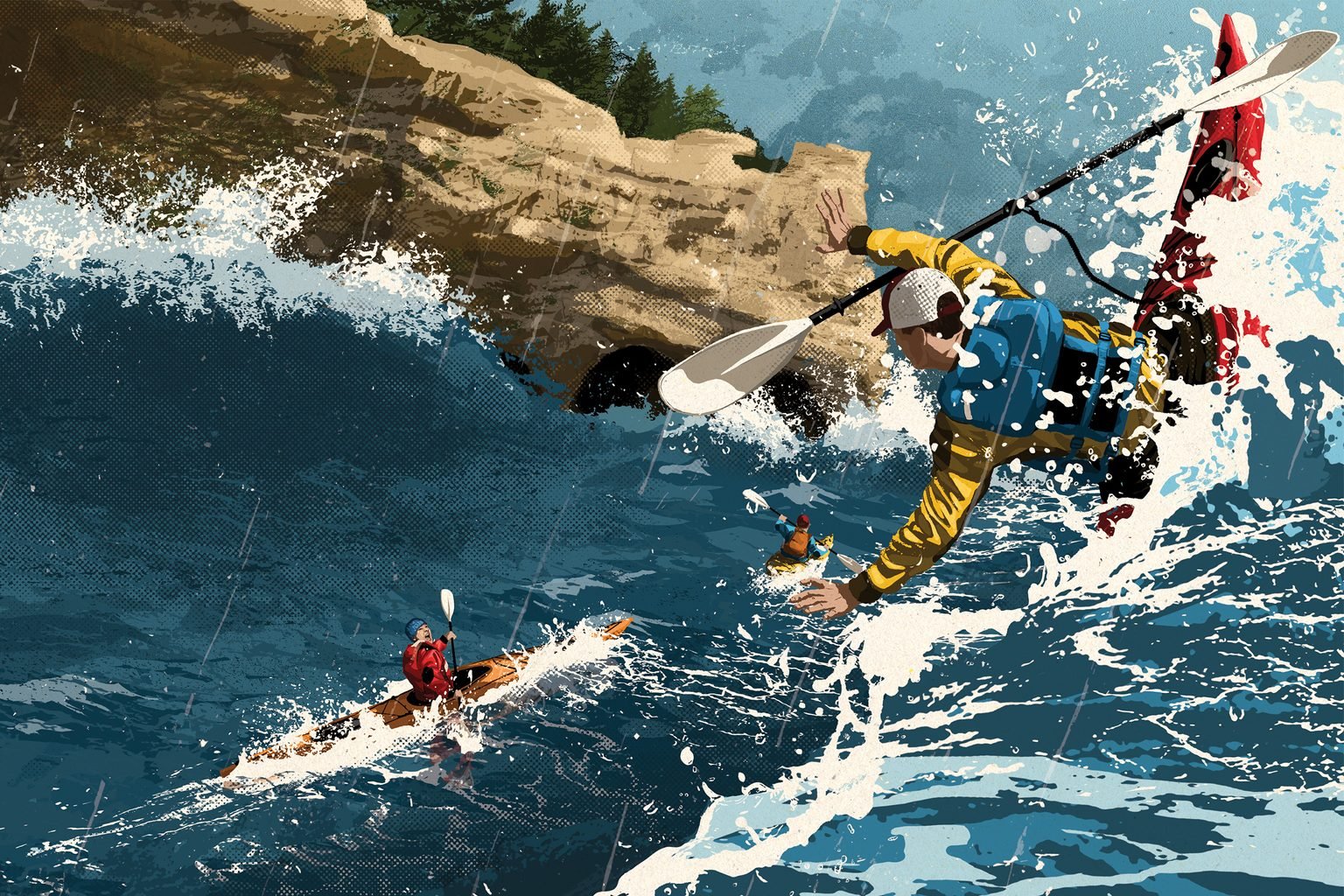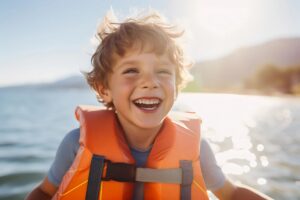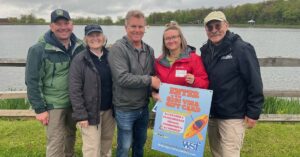
One by one, the three kayakers capsized in the cold, angry water. Then they became separated.
It was meant to be another boys’ trip, the latest in a tradition that stretched back more than two decades. Every other year, the old friends—Jim Farrington, 49, an electrical lineman in Alden, Michigan; Sean Royston, 47, an electrical grid systems manager in Cottage Grove, Wisconsin; and Tolan Annis, 53, the co-owner of a craft distillery in Grand Ledge, Michigan—had kissed their wives goodbye and headed out on an expedition. This time they decided to kayak Lake Superior’s Pictured Rocks National Lakeshore, a challenging out-and-back route.
A trip to remember
On the morning of September 13, 2016, they loaded up on food and camping gear, donned waterproof paddling pants and quick-dry T-shirts, and zipped up their life jackets. The forecast called for winds building to ten knots and seas rising to one to three feet by early afternoon, then stronger winds overnight. The friends were undeterred. They climbed into their 14- to 16-foot-long sea kayaks and, at about 10:30, pushed off from the beach at Sand Point, less than 100 yards from the park headquarters. They planned to return in a week.
The trio punched out through small waves and headed northeast. Soon the national lakeshore’s trademark cliffs began to rise on their right. Their next chance to get out of their kayaks would be some five miles ahead, beyond a tourist overlook called Miners Castle Point.
Away from the shore, the headwind grew to the forecasted ten knots and kept rising. The waves grew to four feet. Still, they never considered turning around. They’d already traveled around four miles, and they had kayaked in worse conditions.
They’d been paddling maybe 90 minutes when, suddenly, the waves grew to six feet and steepened. The wind rose to 20 knots. “When it went bad, it went bad fast,” says Annis, who was in the lead, about 60 feet ahead of Farrington. Royston trailed another 40 or 50 feet behind Farrington.
Royston was the first to go over board.
It was a bad place for a swim. The water was a chilly 62 degrees, and the wind and choppy waves were pushing him toward cliffs 100 yards away. Miners Castle Point was maybe a quarter-mile upwind, and the closest safe landing beach was another quarter-mile beyond that.
Longtime friends separated
After Royston tipped, Farrington quickly paddled over to him. He brought his boat parallel to Royston’s and steadied it as Royston scrambled into his cockpit, which was now full of water. He began working the small plastic hand pump but couldn’t stay ahead of the waves.
“The pumping was just no use,” Royston says. “I’d get close, and another wave would come over us.”
Meanwhile, the wind pushed them closer to the cliffs, where the waves became even steeper. One wave rolled both Royston and Farrington into the water.
Farrington managed to get back into his boat, as did Royston—his second re-entry of the day. When they looked up, they saw Annis in the water, farther out, clinging to his boat. Farrington and Royston pressed their kayaks together for stability, each holding on to the other’s kayak with one hand while paddling with the other. But with the boats heavy with water, and facing big swells and 20-knot winds, they couldn’t make any progress. Annis was on his own.
“By then my arms were giving out,” Royston says. “I looked at Jim and said, ‘I can’t do this anymore.’ We kept getting closer and closer to the cliffs, and at some point I said, ‘We gotta call now.’”

Using a VHF radio clipped to his life jacket, Farrington called: “Mayday, three kayakers stranded at Miners Rock.” But there was no response, because no one heard the calls. The tall cliffs blocked the radio signal from reaching the park’s headquarters or anyone else on land, and no vessels were on the lake. A small-craft advisory had been issued just after the kayakers launched, so the tour boats that normally ply the lakeshore were tied to their piers.
Another wave slammed into the boats, and Farrington capsized a second time. When he got back into the kayak, the radio was gone, stripped from his life jacket, as were his cell phone and GPS unit.
Throughout the ordeal, Royston and Farrington had been trying to make it around Miners Castle Point, about a quarter-mile upwind. Now they realized that even that short distance was impossible in their waterlogged kayaks, and they began looking for an alternative.
They allowed the wind and waves to push them toward a narrow rocky ledge at the base of the cliffs. Maybe they could land there and drain their kayaks before continuing around the point. But when they arrived, they realized the ledge was an illusion. It was actually a partially submerged strip of sandstone, and it was being pummeled by head-high waves.
Farrington somehow managed to get onto the sandstone. He gripped the plastic T-handle in the bow of his kayak, which Royston held tightly against his own kayak. Farrington’s grip held, but the handle didn’t. It tore clean off. The two boats slid back into the crashing surf and, in the process, tossed Royston back into the water.
The waves pushed Royston, and the boats, along the shoreline before he disappeared around a small outcropping.
“The last time I saw him, he was rolling through the waves,” Farrington says. “And I swore his life jacket was unzipped.”
It was roughly 12:30. Two hours after shoving off, all three men were now separated. As far as Farrington knew, Royston was likely already dead. And Annis was nowhere to be seen. Now he was stranded on the rocks, and his radio and cell phone likely were somewhere on the bottom of Lake Superior.
Farrington tried walking the narrow strip of shoreline like a tightrope artist, but the waves kept knocking him off the rocks. As he clawed his way out of the water a third time, Annis came floating by, holding his boat with one hand on the cockpit rim. He’d been kicking toward Miners Castle Point for more than an hour, trying to get around the point to land at Miners Beach, but he had lost ground in the powerful wind.
The men yelled to each other, but communication was hopeless. Soon, Annis disappeared from sight around another small outcropping.
Alone again, Farrington found a broken tree trunk and used it to scramble off the rocks, eventually climbing about halfway up the 90-foot cliff face. He could climb no farther; it was too steep. The Miners Castle Point overlook was just above him, close enough that he could hear the thump of car doors closing as families visited the scenic attraction. He hollered until he was hoarse, but no one heard him.
“Start kicking!”
Royston struggled in the surf until the waves finally spat him away from the shoreline and farther out in the lake. Exhausted, he floated on his back and considered his options.
Miners Castle was barely a quarter-mile to the northeast, but with the wind and swell coming from that direction it may as well have been on the moon. Royston decided to turn downwind toward Sand Point, where they had launched that morning, three-and-a-half miles away.

But the distance wasn’t all that concerned him. Though he didn’t feel particularly cold, Royston knew it was only a matter of time until hypothermia set in. He needed to get out of the water, and quickly. “I’m a swimmer,” he says, “and I thought, Well, let’s just start kicking.”
After about three hours, Royston made it most of the way back to Sand Point, where the cliffs finally gave way to a cedar swamp. “I got to a point where I could actually walk up and grab some of the branches.” After half an hour of wading through thick foliage, he came to the mouth of a creek. It gave him just enough of an opening to drag himself out of the water.
He followed the creek bed into the cedar thicket and spotted a dirt hiking trail. He started down the trail as fast as his wobbly legs could walk, blowing past an older couple taking pictures, until he reached the parking lot. And that’s when dumb luck finally took a shine to Sean Royston. A park ranger happened to be driving by. Royston waved him down.
It was just before 5 p.m. Royston, Farrington, and Annis had gone into the water four-and-a-half hours earlier. Finally, a search-and-rescue operation set out to help locate his missing friends. The National Park Service launched its patrol boat Arrowhead and began scanning the shoreline between Sand Point and Miners Castle. The Coast Guard dispatched a 45-foot patrol boat and scrambled a rescue helicopter.
Stranded, but not for long
Since becoming separated from Royston, Farrington hadn’t moved much from where he was standing midway up the 90-foot cliff. Wearing his bright red paddling top and life jacket, he was like a beacon against the tan sandstone wall. Though he’d lost his glasses in the water, he spotted the Arrowhead’s flashing light bar coming around a bend.
“The biggest relief in my life was seeing those blue flashing lights that no one ever wants to see in the rearview mirror,” Farrington says.
Using the boat’s loudspeaker, rangers told him to stay put. A rescue was underway.
The chopper arrived at 6:29 p.m. It wasn’t going to be an easy rescue. To pluck Farrington from his spot, the pilots would have to hover uncomfortably close to the tree-lined sheer cliff. They would have to lower a rescuer from more than five times the preferred height—using 210 feet of cable when they normally use only 40—all in swirling 20-knot winds. Leaves, twigs, and debris rained down on Farrington as the rescuer descended. He strapped himself to Farrington, then the two were hoisted back into the helicopter.
The streetlights were glowing when the chopper set down after 7 p.m. in the parking lot of Munising Memorial Hospital, where Farrington was finally reunited with Royston.

After refueling, the helicopter lifted off to search for Annis, who by now had been in the water for seven hours. The search centered around Miners Castle, where he’d last been seen. But Annis was already miles to the west.
An abandoned plan
When Annis capsized, he was about 150 feet from the others—too far away for them to help or communicate. After failing several times to climb back into his kayak, he chose to wait for the others to assist him. But the next time he looked for Royston and Farrington, they were gone.
Annis resolved to stay with his orange kayak at all costs; it would be easier for rescuers to spot than a lone swimmer dressed in blue and gray. The kayak offered flotation and was packed with the food and dry clothes he’d need if he managed to reach the shore. That was his plan—kick with the kayak around Miners Castle and land at Miners Beach. The problem: 20-knot winds were whipping around the point, making progress in that direction all but impossible. Eventually, Annis abandoned his plan and turned west instead.
While the hours flowed together, Annis kept kicking. “Normally when you have a situation go bad on you it happens fast, and adrenaline carries you through it. But after seven hours—there’s no adrenaline left,” he says. “I had no sense of time, but I’d seen the sun go across the sky. I could start to feel myself becoming hypothermic. I was getting sleepy, my hands were shaking, and I thought, You’ve gotta get out of this water soon or it’s not going to end well.”
About a mile from Sand Point, where their journey began, he saw his chance: a low spot in the cliff with a thick tree root reaching down.

“The boat was full of water and the waves were beating it hard, so as I was trying to grab this root, the boat became a weapon against me,” he says. Annis made the difficult decision to let the kayak go, along with the provisions it held. He pulled himself up the root to the edge of the thicket atop the low cliff. By the time he got there, the boat had drifted out of sight.
Annis continued along the ridgeline, hoping the boat might get caught up in the underbrush. And that’s exactly what happened. He scrambled down the cliff to his kayak and recovered a few pieces of essential gear, including a change of clothes. He swigged water down his parched throat and ate handfuls of trail mix. Then he grabbed the phone he kept in a waterproof box.
There’s very little cell service around Pictured Rocks, but Annis caught a signal. “The 911 operator knew who I was,” he says. “She told me, ‘We’ve already got the other two. Stay put.’”
Soon, the helicopter was circling directly above Annis. They couldn’t see him in the dusk until a pinprick of light shone through the underbrush. It was Annis signaling with his headlamp.
The helicopter held steady to mark Annis’s position as a team of National Park Service rangers made their way to him. The rangers judged him well enough to hike out, and they bushwhacked back to the trail in the darkness, then walked a half mile back to Sand Point, where his journey had begun.

The rangers asked Annis if he wanted to be taken to the hospital. His response was emphatic. “No way,” he said. “My Jeep is a block away. I’d just as soon go to the hospital and pick the other guys up.”
When he arrived at the emergency room, Annis found Farrington and Royston. They had changed out of their wet clothes and into hospital scrubs and socks. Annis took them shoe shopping at the only store still open, a supermarket. “All they had were women’s flip-flops with sparkles, so they bought a couple pairs,” says Annis.
The restaurants were all closed, but sympathetic workers at a nearby casino listened to their story and reopened the kitchen for them.
When the server came over and asked what they wanted, Annis, the distillery owner, ordered first: “Whiskey.” The three friends toasted their good fortune and gorged themselves on fried chicken strips.
The next day they walked the shoreline—Farrington and Royston still in scrubs and women’s sandals—and recovered all three boats, as well as wallets, keys, and most of their gear.
Their vacation lasted only one day, but all three were more than ready to return to their families.
Originally Published in Reader’s Digest



